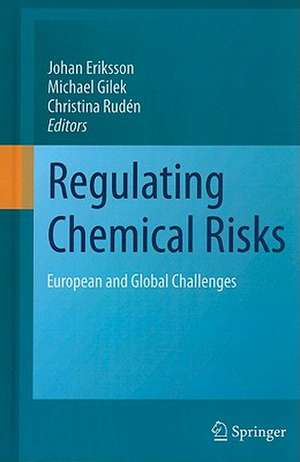Regulating Chemical Risks: European and Global Challenges
Editat de Johan Eriksson, Michael Gilek, Christina Rudénen Limba Engleză Hardback – 3 sep 2010
| Toate formatele și edițiile | Preț | Express |
|---|---|---|
| Paperback (1) | 947.67 lei 6-8 săpt. | |
| SPRINGER NETHERLANDS – 28 oct 2014 | 947.67 lei 6-8 săpt. | |
| Hardback (1) | 952.26 lei 6-8 săpt. | |
| SPRINGER NETHERLANDS – 3 sep 2010 | 952.26 lei 6-8 săpt. |
Preț: 952.26 lei
Preț vechi: 1161.29 lei
-18% Nou
Puncte Express: 1428
Preț estimativ în valută:
182.24€ • 197.88$ • 153.08£
182.24€ • 197.88$ • 153.08£
Carte tipărită la comandă
Livrare economică 23 aprilie-07 mai
Preluare comenzi: 021 569.72.76
Specificații
ISBN-13: 9789048194278
ISBN-10: 904819427X
Pagini: 364
Ilustrații: XII, 350 p.
Dimensiuni: 155 x 235 x 26 mm
Greutate: 0.64 kg
Ediția:2010
Editura: SPRINGER NETHERLANDS
Colecția Springer
Locul publicării:Dordrecht, Netherlands
ISBN-10: 904819427X
Pagini: 364
Ilustrații: XII, 350 p.
Dimensiuni: 155 x 235 x 26 mm
Greutate: 0.64 kg
Ediția:2010
Editura: SPRINGER NETHERLANDS
Colecția Springer
Locul publicării:Dordrecht, Netherlands
Public țintă
ResearchCuprins
Chemical Risk Assessment and Risk Communication.- Risk Governance: Contemporary and Future Challenges.- Communicating Chemical Risks: Beyond the Risk Society.- Framing Chemical Risks in Sweden and Poland: Journalists’ Narratives and Media Texts.- REACH: What Has Been Achieved and What Needs To Be Done?.- Improving the Value of Standard Toxicity Test Data in REACH.- Testing in Aquatic Ecotoxicology: What Are the Scientific Conditions for the ‘3R’ Concept?.- Chemical Risk Assessment in Toxicological Perspective.- Occupational Exposure Limits in Comparative Perspective: Unity and Diversity Within the European Union.- Scientific Uncertainty and Science-Policy Interactions in the Risk Assessment of Hazardous Chemicals.- Assessing Chemical Risks: Evaluating Products Rather than Substances, and the Case of Anti-fouling Paints.- Chemical Regulation: Politics, Policy and Management.- Global Trends in Chemicals Management.- Regulating Chemical Risk: REACH in a Global Governance Perspective.- The Precautionary Principle in EU and US Chemicals Policy: A Comparison of Industrial Chemicals Legislation.- Chemical Regulations in Central and Eastern Europe: The Pull of Transnational Markets and Associations.- Capacity Building for Chemicals Control: Legislation, Institutions, Public–Private Relationships.- Scientific Committees and EU Policy: The Case of SCHER.- Implementing Chemical Regulation: The Role of Inspectors.- Conclusion.- Regulatory Futures in Retrospect.
Recenzii
From the reviews:
“This multiauthored monograph stems from research and a conference on regulating chemical risk in the Baltic area. … This work is useful as a supplementary reference for students in the sciences, journalism, and environmental law. Summing Up: Recommended. Upper-division undergraduates through professionals, general audiences.” (R. E. Buntrock, Choice, Vol. 48 (9), May, 2011)
“This multiauthored monograph stems from research and a conference on regulating chemical risk in the Baltic area. … This work is useful as a supplementary reference for students in the sciences, journalism, and environmental law. Summing Up: Recommended. Upper-division undergraduates through professionals, general audiences.” (R. E. Buntrock, Choice, Vol. 48 (9), May, 2011)
Textul de pe ultima copertă
This important contribution to the scientific understanding of chemical risk regulation offers a coherent, comprehensive and updated multidisciplinary analysis, written by leading experts in toxicology, ecotoxicology, risk analysis, media and communication, law, and political science. The text focuses in particular on the new European REACH regime and its nature, causes and consequences. It examines the regime in the context of the interplay between science and policy, the role of the media, human health, and the environment. Other regulatory systems at both domestic and international levels are also studied, including the UN’s Globally Harmonised System (GHS) for chemical labelling, as well as developments in the U.S. In addition, readers will find analyses of a number of new and still largely uncharted regulatory systems, along with in-depth assessments of their complexity and transnational nature.
Caracteristici
Analyses international initiatives and cooperation Offers comprehensive coverage of chemical risk assessment and risk management Up-to-date on developments in key research fields and policy domains Multidisciplinary perspectives, drawing on both life sciences and social sciences Includes supplementary material: sn.pub/extras













